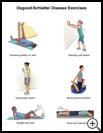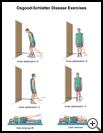
Osgood-Schlatter Disease Exercises
Your healthcare provider may recommend exercises to help you heal. Talk to your healthcare provider or physical therapist about which exercises will best help you and how to do them correctly and safely.
You can start stretching the muscles in the back of your leg by doing the hamstring and calf stretches right away. When you have only a little discomfort in the upper part of your shin, you can do the rest of the exercises.
- Hamstring stretch on wall: Lie on your back with your buttocks close to a doorway. Stretch your uninjured leg straight out in front of you on the floor through the doorway. Raise your injured leg and rest it against the wall next to the door frame. Keep your leg as straight as possible. You should feel a stretch in the back of your thigh. Hold this position for 15 to 30 seconds. Repeat 3 times.
- Standing calf stretch: Stand facing a wall with your hands on the wall at about eye level. Keep your injured leg back with your heel on the floor. Keep the other leg forward with the knee bent. Turn your back foot slightly inward (as if you were pigeon-toed). Slowly lean into the wall until you feel a stretch in the back of your calf. Hold the stretch for 15 to 30 seconds. Return to the starting position. Repeat 3 times. Do this exercise several times each day.
- Quadriceps stretch: Stand at an arm's length away from the wall with your injured side farthest from the wall. Facing straight ahead, brace yourself by keeping one hand against the wall. With your other hand, grasp the ankle on your injured side and pull your heel toward your buttocks. Don't arch or twist your back. Keep your knees together. Hold this stretch for 15 to 30 seconds.
- Rectus femoris stretch: Kneel on your injured knee on a padded surface. Place your other leg in front of you with your foot flat on the floor. Keep your head and chest facing forward and upright and grab the ankle behind you. Gently bring your ankle back toward your buttocks until you feel a stretch in the front of your thigh. Hold 15 to 30 seconds. Repeat 2 to 3 times.
- Straight leg raise: Lie on your back with your legs straight out in front of you. Bend the knee on your uninjured side and place the foot flat on the floor. Tighten the thigh muscle on your injured side and lift your leg about 8 inches off the floor. Keep your leg straight and your thigh muscle tight. Slowly lower your leg back down to the floor. Do 2 sets of 15.
- Prone hip extension: Lie on your stomach with your legs straight out behind you. Fold your arms under your head and rest your head on your arms. Draw your belly button in towards your spine and tighten your abdominal muscles. Tighten the buttocks and thigh muscles of the leg on your injured side and lift the leg off the floor about 8 inches without arching your back. Keep your leg straight. Hold for 5 seconds. Then lower your leg and relax. Do 2 sets of 15. When this becomes easy for you, you can add a 1 to 2-pound ankle weight.
- Knee stabilization: Wrap a piece of elastic tubing around the ankle of your uninjured leg. Tie a knot in the other end of the tubing and close it in a door at about ankle height.
- Stand facing the door on the leg without tubing (your injured leg) and bend your knee slightly, keeping your thigh muscles tight. Stay in this position while you move the leg with the tubing (the uninjured leg) straight back behind you. Do 2 sets of 15.
- Turn 90 degrees so the leg without tubing is closest to the door. Move the leg with tubing away from your body. Do 2 sets of 15.
- Turn 90 degrees again so your back is to the door. Move the leg with tubing straight out in front of you. Do 2 sets of 15.
- Turn your body 90 degrees again so the leg with tubing is closest to the door. Move the leg with tubing across your body. Do 2 sets of 15.
Hold onto a chair if you need help balancing. This exercise can be made more challenging by standing on a firm pillow or foam mat while you move the leg with tubing.
- Side-lying leg lift: Lie on your uninjured side. Tighten the front thigh muscles on your injured leg and lift that leg 8 to 10 inches (20 to 25 centimeters) away from the other leg. Keep the leg straight and lower it slowly. Do 2 sets of 15.
- Clam exercise: Lie on your uninjured side with your hips and knees bent and feet together. Slowly raise your top leg toward the ceiling while keeping your heels touching each other. Hold for 2 seconds and lower slowly. Do 2 sets of 15 repetitions. When this exercise becomes easy for you, you can add a resistance band around your thighs.
Developed by Change Healthcare.
Pediatric Advisor 2022.1 published by Change Healthcare.
Last modified: 2019-08-09
Last reviewed: 2019-08-05
Last modified: 2019-08-09
Last reviewed: 2019-08-05
This content is reviewed periodically and is subject to change as new health information becomes available. The information is intended to inform and educate and is not a replacement for medical evaluation, advice, diagnosis or treatment by a healthcare professional.
© 2022 Change Healthcare LLC and/or one of its subsidiaries


